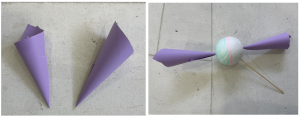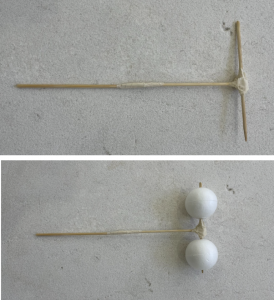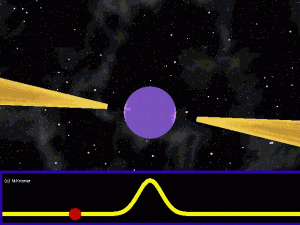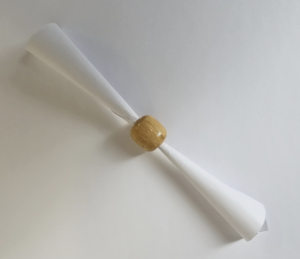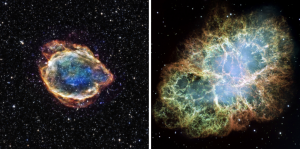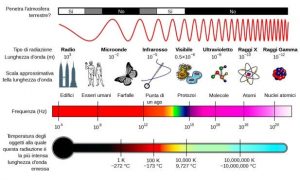Teaching activity planned by Leonardo De Deo, Greta Toni and Rachele Toniolo during the PhD course “Designing innovative public engagement activities” held at the University of Padova in 2024.
Short description of the Activity
Did you know that in the Universe there are objects behaving like clocks? We are talking about pulsars, peculiar stars emitting light pulses with an extremely precise rhythm. However, even the best sometimes miss a beat.
In this laboratory, we will play with pulsars and their rhythm, and will discoverir how they are used to study one of the most incredible phenomena of the cosmos: gravitational waves!
Materials
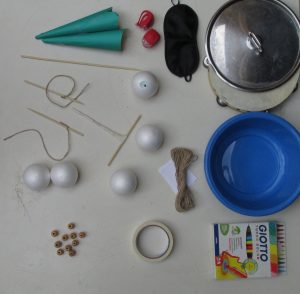 For the introduction
For the introduction
- 1 small styrofoam ball, with a diameter as desired (we suggest 10 cm)
- 1 sheet of coloured paper
- 1 long toothpick
- 2 (small) bike spotlights
- Animation + explanatory (link for download: image1, image2, image3, animation)
- Phone/computer to reproduce both animation and images
- A basin filled with water
- Styrofoam balls (2 or more)
- Long toothpicks
- Tape
- Scotch
For the pulsars’ construction
- Wooden beads with a diameter of about 2 -3 cm
- Sheets of white and/or coloured paper
- Felt-tip Pens
Preparing the activity
Before the arrival of participants, materials should be prepared for the various stages of the activity.
3D Model of a pulsar
1. Divide a coloured sheet by half and create two cones with a very narrow tip. Use adhesive tape to secure the edges.
2. Insert the tip of paper cones in the polystirene tip, approximately at two diametrically opposed poles. In case, use a toothpick to pierce the ball.
3. Insert a toothpick anywhere in the sphere to use as a support.
4. Insert a bicycle spotlight in each cone, to reproduce the “lighthouse” effect by rotating the pulsar.
Experiment
1. Build a “T”-shaped stant with toothpicks and paper scotch.
2. Insert two small styrofoam balls along the short arms of the “T”.
Description of the activity
Introduction
1. First of all, welcome participants and introduce yourself. Shortly illustrate the activity, trying to encourage a discussion between yourself and the group, rather than a one-way explanation. In order to do that, you can ask questions, such as: “Welcome to the laboratory “Even pulsars miss a beat!” In your opinion, what are we going to do? Have you ever heard of pulsars? Do you know what they are?”
2. Then tell them what pulsars are.
Pulsars are small stars (with a diameter of about 20 km) rotating very quickly on themselves. They are the remains of stars similar to our Sun, but blue and much heavier, which by the end of their life explode, releasing into space all the material of which they composed. At the centre of these explosions (which astronomers call supernovae) we find the unexploded “kernel” of the star, which keeps rotating quickly on itself.
(Show the following images during the explanation)
A blue star, heavier than our Sun (Rigel, on the left), the residue after its explosion ( Carb Nebula, in the centre), and a close-up view of the pulsar at its centre (on the right).
3. Slower pulsars take 20 seconds to spin around themselves, whereas the quicker and common ones take thousandths of second (Make them test how “small” a millisecond is, trying to get hands clapping as many times as possible in one second – you will never reach a thousand times per second!).
4. The quick rotation of pulsars means that the gas remaining around them is thrown along long and powerful jets, which we receive on Earth as rhythmic and extremely precise pulses.
We see the instant in which the beam of light points in our direction. For a more familiar analogy, we can think of the lighthouses in the harbours: from afar they seem light (pulses) which turn on and off, but it is actually a light spinning on itself. We can see the light coming from the lighthouse only when, during the light’s rotation, it points exactly on us.
(In order to explain this better, use the model you made beforehand, letting each participant rotate the model, so as to reproduce the “lighthouse” effect).
5. In particular, the light we receive is actually invisible to our eyes, and is called radio light. It can only be seen by using special telescope, defined as radiotelescopes.
DueTwo radiotelescopes at Medicina, a small town in the province of Bologna.
First part – Sound Lab
At this stage, each participant will represent the pulses sent by a pulsar, beating with a wand on an improvised instrument (for example percussion, pots and containers, but also a pen beating on an exercise book). This stage works well with up to 5 people.
6. Give each participant an instrument and a wand to play it. Just like a conductor, ask them to choose the rhythm they prefer, and start making them execute one by one (adding the instruments one at a time). It does not matter whether it is quick or slow: the main thing is that they keep it in constant. In this way, each one will simulate a different pulsar.
Remind them that what they are doing (convert a light signal into an audible signal) is only a metaphor. In fact, pulsars do not emit sounds, but rather radio light.
7. A fundamental feature of pulsars is the extreme precision of their rotation. Thanks to their precision, pulsars are used to detect almost imperceptible phenomena, which take place in the Cosmos, such as gravitational waves.
“Do you know what gravitational waves are? Let us show it with a simple experiment!”
8. Take a basin full of water, and explain that the surface of the water represents the space: in the initial situation the water is calm (the space is empty).
9. At this point, take the T-shaped structure built beforehand and make it rotate at water level. The styrofoam balls attached represent two stars, which circle one around the other. Make them notice that their rotation creates ripples on the water surface: these are gravitational waves, which can actually be observed in the space (show the following animation, it you think it may be useful).
10. Explain that pulsars are affected by this phenomenon, and that from the Earth we observe a variation in the period/rhythm of pulsars themselves, because the signal takes more or less time to reach us while following the waves, as the buoys follow these of the sea. These changes are imperceptible for us; however, thanks to the extremely sensible radiotelescopes used by scientists, we can detect even the smallest variations of their rhythm!
11. It is now time to simulate a passing gravitational wave, which we simulated in the preceding experiment. Show the group what happens when pulsars are crossed by a wave: simulate a rhythmic pattern for a few seconds, and suddenly raise your arms higher, and then come back to your rhythm (as if you were struck by a seawave, that raises and then lowers the hand with which you are playing).
12. Now let them all play together: everyone starts with his/her own rhythm and, alt the facilitator’s signal, comes the wave that changes the rhythms of the pulsars.
13. At this point, ask from the whole group the participation of a voluntary, who will act as astronomer, and will try to understand from which direction the gravitational wave is coming. Blindfold the volunteer, and ask him/her to open his/her arms (like a radio antenna!), and ask the other participants to stand all around the volunteer astronomer.
14. Pulsars start to send their impulses, one at a time. By a previously agreed signal (for example a nod or a hand on a shoulder) report a gravitational wave passing through a single pulsar. Wait for about 10 seconds before and after starting the wave. When you think it is appropriate, stop the pulsars, take off the volunteer’s bendage, and ask them to guess from which direction the wave arrived.
15. Alternate the person in the middle, so that all the group’s participants act as astronomer at least once. If there is enough time, yon even organize more turns (or, at a more difficult level, in which you simulate the passage of two gravitational waves).
Second part – Building pulsars
The last step of the laboratory consists in building a pulsar for each participant, so thay everyone may have a souvenir of the activity to take home.
16. Place on the table several and/or coloured white sheets, cut into strips (about) 7.5 cm x 5.5 cm, and let each participant choose two of their favourite colour (personalizing them with markers).
17. With each strip, let them make (or make yourself beforehand, if you are short on time) a small cone with a very narrow point, using the tape to fix it. The two cones (which represent the light beams) should be inserted into the holes of a wooden bead (which represents the pulsar). Thus you have created a very personal pulsar!
Example of a pulsar to be used as a gadget (here with white sheets, for illustrative purposes).
Explanation of the physical process
Supernovae
A Supernova is a spectacular event, which marks the explosion of a very massive star, over eight times our Sun. The light emitted can be compared with the light which our Sun can emit in a billion years.
Supernovae are crucial in the formation of the chemical elements of the Universe. Apart from Hydrogen, Helium and Lithium, formed during the Big Bang, all the other elements, such as Carbon and Oxygen, are made inside the stars. Following the explosion of Supernovae, the stellar matter, rich in chemical elements is released in the Cosmos, creating new stars and planets (such as the Earth): in this sense, we really are “children of the stars”!
Two examples of supernovae, in which various colours correspond to different chemical elements released in the environment following the explosion.
Pulsar
A pulsar (from the merger of two English words “pulsating star”) is a small star (with a diameter of about 20 km) which rotates very quickly on itself, up to thousands of times per second. Pulsars are the residue of stars heavier than our Sun (eight to twelve times its mass), which at the end of their life explode like Supernovae (see above): in the middle of these latter, there is the “core” of the star, which is extremely compact, which keeps rotating quickly on itself, i.e. the pulsar.
The quick rotation of pulsars causes the gas to be thrown along long and powerful jets. Because of such jets, pulsars emit intense beams of light, which we receive on the Earth as rhythmical and extremely precise beams.
Radio waves
Radio waves are a kind of electromagnetic waves (the physical name which is given to the phenomenon of light) invisible to the human eye. The human being exploits them for communications: any wireless device (telephones, wi-fi modem, computer, remote control of the machine, radio, etc.) is planned to emit and receive radio waves, which are then translated into sounds or images (for example calls or messages).
In Astrophysics radio waves, like any other type of visible and invisible light, are emitted by some celestial objects. In order to receive them it is necessary to use radiotelescopes, a particular kind of telescopes planned to “see” radio waves.
The set of known electromagnetic waves.
Space-Time
In Physics, with the term “space-time” we mean the four-dimensional structure of the Universe, theorized by Einstein in his Theory of Relativity.
According to this thesis, the Universe has a 4-dimensional structure: 3 space dimensions (length, depth and width) and a temporal dimension. In this way, it is also possible to explain the concept of gravity, as this short video explains (link)
Gravitational waves
Gravitational waves are oscillations (waves) of space-time travelling at the speed of light. They are generated when two bodies orbit one around the other. The heavier their mass, the larger the wave they create.
Nowadays, the onlye gravitational waves we managed to detect are the ones generated by the union of black holes, as explained in this short video (link).
Useful Links:
Pulsars reveal the breath of Space-Time – MEDIA INAF
Gravitational Waves: pulsars reveal the calm breath of the Universe

